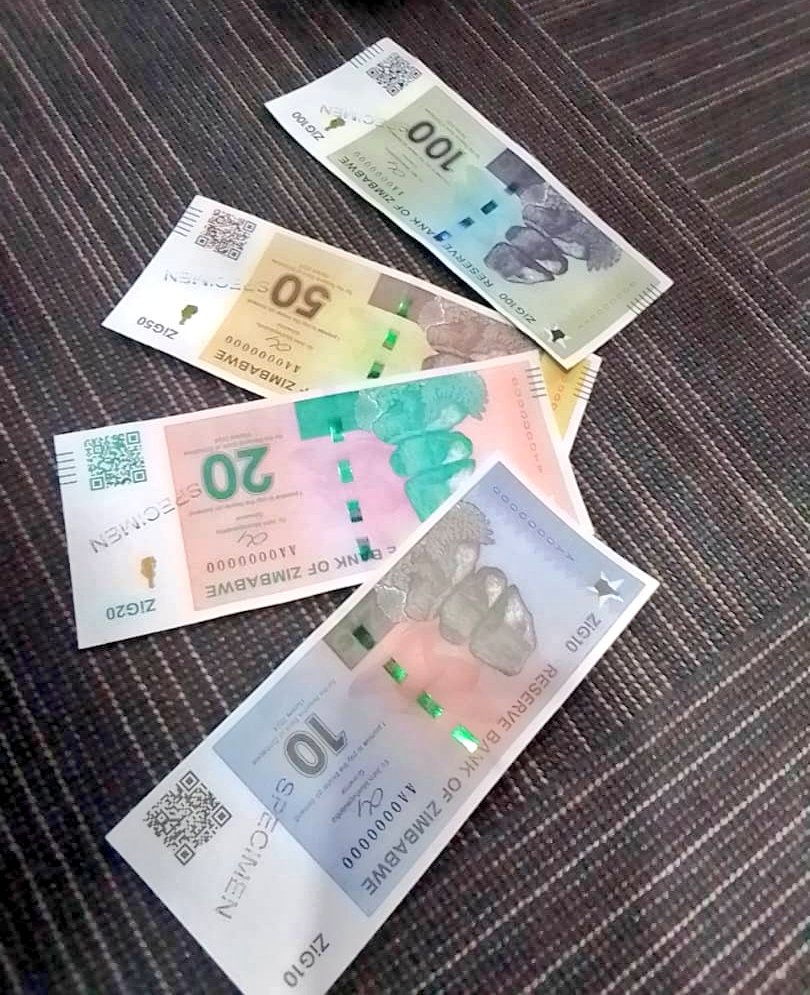Zimbabwe introduces new gold backed currency
By Delicious Mathuthu
Zimbabwe on Friday introduced a new currency backed by mineral and foreign currency reserves as government continues efforts to arrest the country’s inflation challenges.
Reserve Bank of Zimbabwe new Governor, Dr. John Mushayavanhu, announced the new structured currency regime saying it will be named the Zimbabwe Gold (ZiG), backed by a basket of mineral reserves centered on gold, as well foreign currency reserves.
He said the current Zimbabwe dollar will cease circulation within 21 days from Friday 5 March 2024, to make way for new money.
The new ZiG comes in the form of 1, 2,
5, 10, 20, 50, 100 and 200 notes while coins will be introduced later.
The new money and policy framework’s main purpose, Dr. Mushayavanhu said, is to re-monitise Zimbabwe’s currency and ensure economic stability.
“Following the recalibration of the bank’s policymaking framework, the new monetary policy measures are intended to achieve… a solid and stable national currency, a stable and sustainable exchange rate, robust policy credibility and restoration of market confidence [and] a stable and sustainable macro economy as enshrined in Vision 2030 and NDS1 (National Development Strategy 1).
“The new policy framework will be implemented sequentially to ensure lasting stability, certainty, and predictability thereby achieving the desired impact on financial, monetary, currency, and exchange rate stability,” Dr. Mushayavanhu said.
The Reserve Bank said the ZiG will be accompanied by new policy measures which will be anchored on key strategies which include the adoption of a market-determined exchange rate system, efficient and optimal money supply management, anchoring the local currency on reserves backed by gold and foreign currency balances, as well as flexibility to adjust to other support measures and obligations in response to market demands.
Making an analysis on the new currency and policy measures, the Zimbabwe Coalition on Debt and Development (ZIMCODD) which has been advocating for utilising locally available national resources such as minerals to revive the economy, says if adhered to, with the Reserve Bank centering on transparency and accountability, they have an ‘excellent potential’ in stabilising the economy.
“If well implemented and underpinned on transparency and accountability, this arrangement of backing the ZiG with reserve assets has excellent potential to bring a lasting solution to Zimbabwe’s decades-old currency conundrum,” the organisation said.
They said a stable currency stabilises economic activities, more so, backing it with national reserve assets restricts haphazard printing of money which fuels inflation.
“A stable currency helps power industrial production, fuel employment creation, leads to stable and affordable prices, and subdues poverty and income inequalities.
“It means that from now on, ZiG’s money supply growth will only be limited to the growth of RBZ’s reserve asset holdings, ceteris paribus.
“So, hypothetically, this arrangement could restrict the ability of authorities to print ZiG willy-nilly. If this holds, the gold-backed ZiG will become a
stable currency, thus clamping ongoing rapid dollarization of the economy.
“Generally, gold is considered a safe haven investment during downturns and financial crises because of its long history of use as a store of value. Its properties are helping it achieve this status: malleability, portability, aesthetic appeal, virtual indestructibility, universal acceptance, liquidity, and rarity,” ZIMCODD said.
On foreign currency trading, Dr. Mushayavanhu said the auction system has been dumped for an interbank foreign exchange market administered under a willing-buyer-willing-seller (WBWS) trading
arrangement.
On the transition from the Zimbabwean dollar to the ZiG, Dr. Mushayavanhu said: “With effect from 5 April 2024, banks shall convert the current Zimbabwe dollar (bond notes) balances into the new currency which shall be called Zimbabwe Gold (ZiG) to foster simplicity, certainty, and predictability in monetary and financial affairs.”
He said the new currency will be used along with other foreign currencies in the market.
The swap rate of the Zimbabwe dollar to the ZiG will be determined by the closing interbank exchange rate and the price of gold on the 5th of April 2024.
All banks operating in Zimbabwe have been ordered to rename their Zwl$ accounts to ZiG accounts.
The Reserve Bank said existing ZiG accounts, which are Gold-backed Digital Tokens, will now be re-named as such, GBDT accounts.
All local currency balances held in bank’s will be converted and credited to the new ZiG accounts while citizens holding Zwl$ cash, without bank accounts, will be free to exchange them at two selected local banks within three weeks.
“The Reserve Bank has made special arrangements for those without bank accounts to swap their ZW$ notes and coins at POSB and AFC Commercial Bank within 21 days after 5 April 2024,” Dr. Mushayavanhu said.
Shops have also been ordered to adjust their prices accordingly.
Mobile network operators who are part of the National Financial Inclusion Strategy have been directed to transition from the Zwl$ to the ZiG by the 8th of April.
Dr. Mushaya said the new currency is well backed with reserves three times the total value of the newly introduced currency.
“As at 5 April 2024, the bank’s reserve asset holdings comprise of USD100 million in cash and 2,522 kg of gold (worth US$185 million) to back the entire local currency component of reserve money which currently stands at ZW$2.6 trillion requiring full (100%) cover of gold and cash reserves amounting to US$90 million.
“The total amount of gold and cash reserve holdings of US$285 million represents more than 3 times cover for the ZiG currency being issued,” he said.



